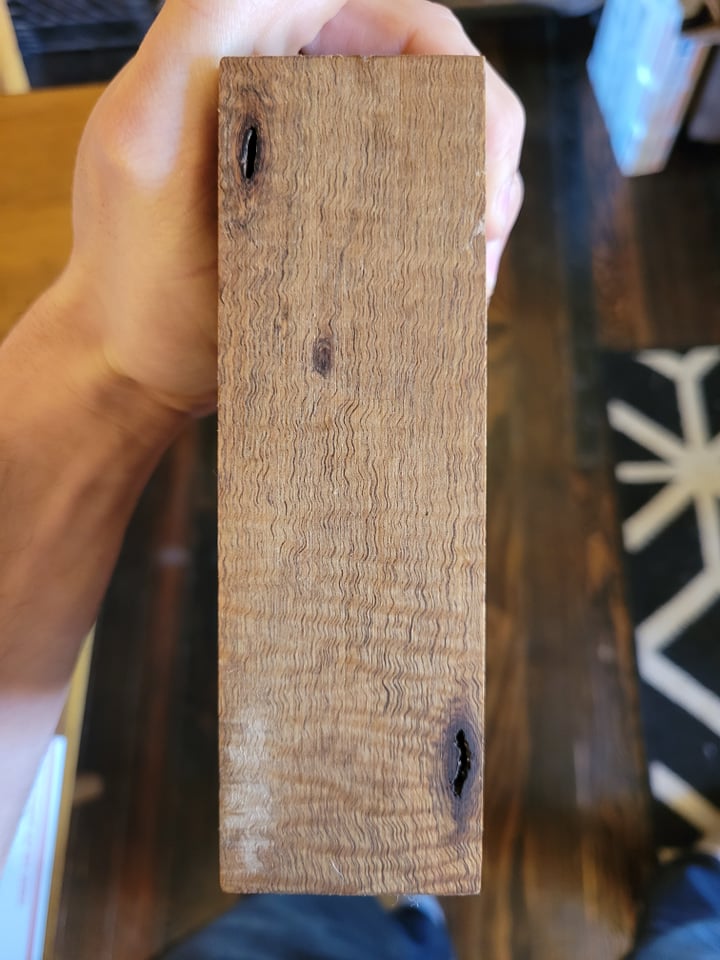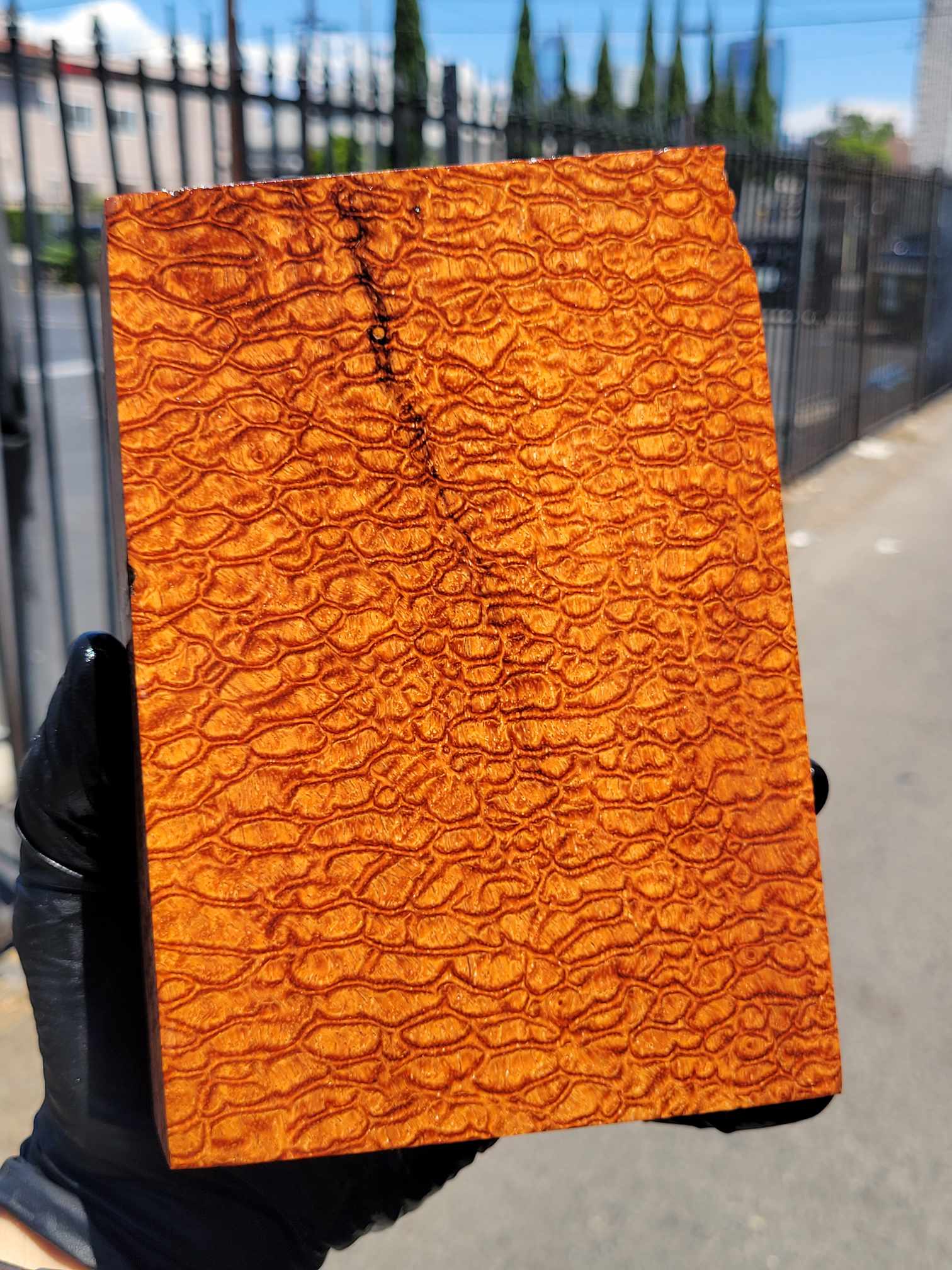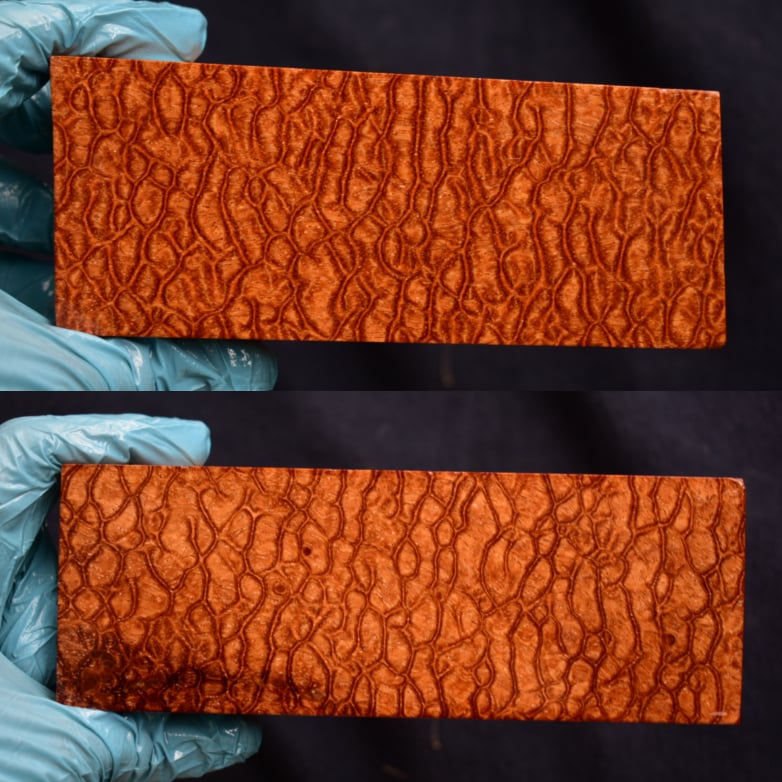- Joined
- Dec 27, 2013
- Messages
- 2,679
Hello Everyone. Im posting an updated version of my What is wood figure post. I had to shorten the post to fit it here, to see the full version, please see the article linked here At my Website
If you would like to use this content for your own website, contact me and you can set up links for this to help people understand and answer questions about wood.
How do I cut wood for figure?
First, two important terms. Flatsawn and quartersawn. These are both easy to find diagrams of, but simply put flat sawn grain is when the surface of is parallel to the grains of the tree, and quartersawn is when the surface of wood is perpendicular to the rings of the tree. People will often describe a piece of wood as being quartersawn, but any piece of wood will have both quarter sand flat sawn sides. I will use the term plane or face to describe a specific surface, referring to a flat or quartersawn face, to describe the figure that would be visible.
I will start with the good stuff first. How to show off the best figure in wood through grain direction.
These are general rules to follow, there will be exception.
Figures best shown in quartersawn wood:
Curly: Also called flame, fiddleback, tiger stripe, ringed or other names These names are all used to describe the same type of curly grain that is tightly bound and often regularly spaced. These closely packed figures will almost always show up best the closer to fully quartersawn the surface is. Fully quartersawn means that the growth rings of the tree intersect the face at a 90 degree angle. The closer to this angle, the stronger the curl figure.
Curly figure is caused by waves in the grain perpendicular to the rings of the tree. If you saw a curly log, the grain on the surface would be moving side to side. Below is the flatsawn side of a piece of curly acacia. You should be able to see that each line of grain moves back and forth, perpendicular to the rings of the tree. Minimal figure is seen here, as the grain is not moving in and out of the plane of the wood. But, when the wood is cut perpendicular to the rings, AKA quartersawn, those waved in the grain now go through that plane, producing the effect of curl.


Sample of curly acacia showing the grain structure of curly wood
Ray Figure: Also known as medullary ray figure, this is best known in woods like lacewood, leopardwood or oak. In densely ray figured woods such lacewood, it will appear as an almost net like figure over the quartersawn surface. The figure is almost imperceptible across flat sawn surfaces
Figures show best in flatsawn wood:
Quilted figure: Quilted figure is sometimes used to describe any wide spaced curl, but quilted figure is inherently different. It is caused by grain undulations parallels to the rings of tree. That means that if you saw the trunk of a tree with quilted figure, it would have a 3d surface as seen below. The surface of the tree has texture, and on the quartersawn face shown, relatively little figure is visible. To show quilted figure, the wood would have to be flat sawn. Since a flatsawn surface would be parallel to the growth rings, and the undulation of quilted figure wood are also parallel to the rings, the figure would appear. In the image below, see how the entire tree has waves in it, traveling up and down the length of the wood? If you were to cut flatsawn, I.E to cut through the waves the grain would alternate flat, then going into the plane, then flat, then coming out. This would cause a quilt figure, with the spacing of the quilt being the period of the waves of the grain
![[IMG] [IMG]](https://i.imgur.com/U4tCZlG.jpg)
Sample of Quilted Eucalptus
Birdseye Figure: Birdseye figure is often misunderstood and sold as being burl figure. It is not, and arises from a different but unknown mechanism. What is known is that the eyes are almost always radial in nature. Like the eyes of a burl, they show best when cut perpendicular to their direction of formation, which means birdseye figure will show best on a flatsawn section. Real birdseye figure is a rare thing, and most often seen in hard maple. Recently, i was able to source Birdseye Viet rosewood, an incredibly rare species that shows true birdseye figure. Birdseye figure is a type of figure that will greatly benefit from a high grit finishing, as more figure will appear as the surface is refined.
View attachment 1409471View attachment 1409470
Birdseye Vietnamese Rosewood
Pommele/ Bubble/ peanut and so on: All of these figures are similar in natural to quilt, the involve movement of grain parallel to the grain of the wood an are thus best shown in flatsawn pieces. One of the most famous and least understood of these is the Xylay figure in Afzelia Xylay. Its an incredibly rare wood, and the strange, bubbling quilted figure is seen best on flat sawn chunks. I have been asking suppliers what they know about it and little information has come to light.
View attachment 1409478


Samples of Afzelia Xylay
Why does curly wood look like that?
The reason curly or quilted or pommele or any other figured wood appears so interesting has to do with a property of wood, that it is anisotropic. That simply means its properties are different depending on direction. This is obvious if you consider the different applications of face vs end grain.
But one of those different properties is their index of refraction, or how much light they absorb or reflect. For a variety of reasons, end grain is less reflective than face grain. And as discussed above, grain can undulate through wood, and if a plane of wood goes through this, in some areas the grain will be rising up out of the surface, in parts it will be flat to the surface, and parts it will be going back down into the surface. These areas where the grain is coming up or going down have part endgrain character, which means they reflect less light than the areas where the grain is flat to the surface. This results in alternating bands of more and less reflective wood, giving rise to figure.
This is why some processes will enhance the appearance of figure, they are increasing the difference between the reflection of the two grain directions. Rough surfaces are less shiny overall, this making the parallel surfaces less noticeable and decreasing the appearance of curl. By contrast, it is incredibly difficult to polish endgrain, so fine finishing and buffing will make the parallel sections more reflective, increasing the appearance of curl. Oil is also absorbed more readily by endgrain, darkening it. This is why finishes like oil or stain will often enhance curl, as the end grain character areas will absorb more and thus further increase contrast.
When this wood is cut perpendicular to the waves and planed, a surface like this is seen.
![[IMG] [IMG]](https://i.imgur.com/Dcgcp3P.jpg)
As you can see, the angle of the grain meeting the surface varies in a repeating pattern. And because the end grain reflects light differently than face grain, a pattern emerges. Across the surface of the block, light shines unevenly and thus gives yield to a curly figure. The appearance of movement to see in figured wood as the light bounces off of it is called Chatoyancy, sometimes called tigers eye as the stone tigers eye has the same effect.
Burmese teak burl, acacia burl, satinwood burl
If you would like to use this content for your own website, contact me and you can set up links for this to help people understand and answer questions about wood.
How do I cut wood for figure?
First, two important terms. Flatsawn and quartersawn. These are both easy to find diagrams of, but simply put flat sawn grain is when the surface of is parallel to the grains of the tree, and quartersawn is when the surface of wood is perpendicular to the rings of the tree. People will often describe a piece of wood as being quartersawn, but any piece of wood will have both quarter sand flat sawn sides. I will use the term plane or face to describe a specific surface, referring to a flat or quartersawn face, to describe the figure that would be visible.
I will start with the good stuff first. How to show off the best figure in wood through grain direction.
These are general rules to follow, there will be exception.
Figures best shown in quartersawn wood:
Curly: Also called flame, fiddleback, tiger stripe, ringed or other names These names are all used to describe the same type of curly grain that is tightly bound and often regularly spaced. These closely packed figures will almost always show up best the closer to fully quartersawn the surface is. Fully quartersawn means that the growth rings of the tree intersect the face at a 90 degree angle. The closer to this angle, the stronger the curl figure.
Curly figure is caused by waves in the grain perpendicular to the rings of the tree. If you saw a curly log, the grain on the surface would be moving side to side. Below is the flatsawn side of a piece of curly acacia. You should be able to see that each line of grain moves back and forth, perpendicular to the rings of the tree. Minimal figure is seen here, as the grain is not moving in and out of the plane of the wood. But, when the wood is cut perpendicular to the rings, AKA quartersawn, those waved in the grain now go through that plane, producing the effect of curl.


Sample of curly acacia showing the grain structure of curly wood
Ray Figure: Also known as medullary ray figure, this is best known in woods like lacewood, leopardwood or oak. In densely ray figured woods such lacewood, it will appear as an almost net like figure over the quartersawn surface. The figure is almost imperceptible across flat sawn surfaces
Figures show best in flatsawn wood:
Quilted figure: Quilted figure is sometimes used to describe any wide spaced curl, but quilted figure is inherently different. It is caused by grain undulations parallels to the rings of tree. That means that if you saw the trunk of a tree with quilted figure, it would have a 3d surface as seen below. The surface of the tree has texture, and on the quartersawn face shown, relatively little figure is visible. To show quilted figure, the wood would have to be flat sawn. Since a flatsawn surface would be parallel to the growth rings, and the undulation of quilted figure wood are also parallel to the rings, the figure would appear. In the image below, see how the entire tree has waves in it, traveling up and down the length of the wood? If you were to cut flatsawn, I.E to cut through the waves the grain would alternate flat, then going into the plane, then flat, then coming out. This would cause a quilt figure, with the spacing of the quilt being the period of the waves of the grain
![[IMG] [IMG]](https://i.imgur.com/U4tCZlG.jpg)
Sample of Quilted Eucalptus
Birdseye Figure: Birdseye figure is often misunderstood and sold as being burl figure. It is not, and arises from a different but unknown mechanism. What is known is that the eyes are almost always radial in nature. Like the eyes of a burl, they show best when cut perpendicular to their direction of formation, which means birdseye figure will show best on a flatsawn section. Real birdseye figure is a rare thing, and most often seen in hard maple. Recently, i was able to source Birdseye Viet rosewood, an incredibly rare species that shows true birdseye figure. Birdseye figure is a type of figure that will greatly benefit from a high grit finishing, as more figure will appear as the surface is refined.
View attachment 1409471View attachment 1409470
Birdseye Vietnamese Rosewood
Pommele/ Bubble/ peanut and so on: All of these figures are similar in natural to quilt, the involve movement of grain parallel to the grain of the wood an are thus best shown in flatsawn pieces. One of the most famous and least understood of these is the Xylay figure in Afzelia Xylay. Its an incredibly rare wood, and the strange, bubbling quilted figure is seen best on flat sawn chunks. I have been asking suppliers what they know about it and little information has come to light.
View attachment 1409478


Samples of Afzelia Xylay
Why does curly wood look like that?
The reason curly or quilted or pommele or any other figured wood appears so interesting has to do with a property of wood, that it is anisotropic. That simply means its properties are different depending on direction. This is obvious if you consider the different applications of face vs end grain.
But one of those different properties is their index of refraction, or how much light they absorb or reflect. For a variety of reasons, end grain is less reflective than face grain. And as discussed above, grain can undulate through wood, and if a plane of wood goes through this, in some areas the grain will be rising up out of the surface, in parts it will be flat to the surface, and parts it will be going back down into the surface. These areas where the grain is coming up or going down have part endgrain character, which means they reflect less light than the areas where the grain is flat to the surface. This results in alternating bands of more and less reflective wood, giving rise to figure.
This is why some processes will enhance the appearance of figure, they are increasing the difference between the reflection of the two grain directions. Rough surfaces are less shiny overall, this making the parallel surfaces less noticeable and decreasing the appearance of curl. By contrast, it is incredibly difficult to polish endgrain, so fine finishing and buffing will make the parallel sections more reflective, increasing the appearance of curl. Oil is also absorbed more readily by endgrain, darkening it. This is why finishes like oil or stain will often enhance curl, as the end grain character areas will absorb more and thus further increase contrast.
When this wood is cut perpendicular to the waves and planed, a surface like this is seen.
![[IMG] [IMG]](https://i.imgur.com/Dcgcp3P.jpg)
As you can see, the angle of the grain meeting the surface varies in a repeating pattern. And because the end grain reflects light differently than face grain, a pattern emerges. Across the surface of the block, light shines unevenly and thus gives yield to a curly figure. The appearance of movement to see in figured wood as the light bounces off of it is called Chatoyancy, sometimes called tigers eye as the stone tigers eye has the same effect.
Burmese teak burl, acacia burl, satinwood burl
